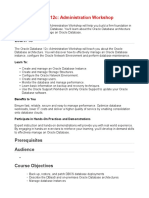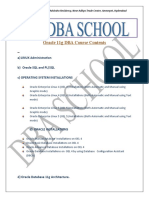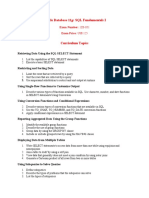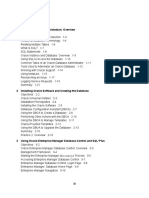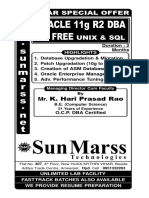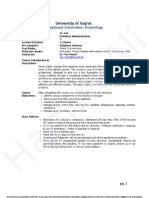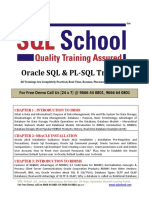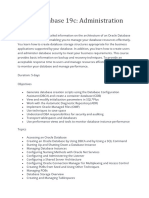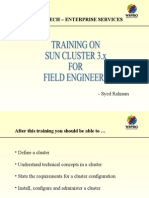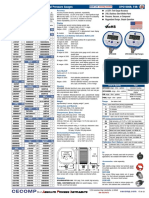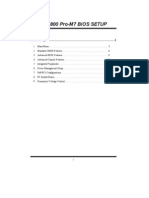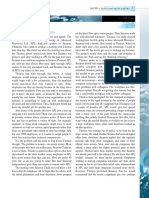Oracle DBA & Cloud Course
Complete Practical & Real-time Training
Training Highlights
Job Support Placement Support
Complete Practical Support Certification
Real-Time Scenarios Interview Preparation
Resume Preparation Material, Practice Labs
Lab Access 100%PlacementAssistance
Trainer: Mr. Shekar Having 15+ years of experience Primary as an Oracle DBA and
Secondary MS SQL Server DBA providing support on Test, Development and
Production environments.
For Free Demo: Call us on
INDIA: +91 9666 44 0801, USA: +1 510 400 4845
Revision, Mock Interviews, Interview & Resume Classes Every Saturday
www.sqlschool.com
� Oracle DBA Course Content
Modules -1- Linux/UNIX Installation & Commands
Chapter 1- Getting Started with UNIX
What is UNIX? * UNIX Architecture [Hardware, Kernel, Shell, Command & Utilities] * How to
Login & Logout in UNIX? * Changing the Password of Logged in User * Listing the Files &
Directories * List out the logged in Users * Modes of Shutdown the Linux/Unix OS
Chapter 2- UNIX File Management & the UNIX VI Editor
List the files & Hidden files * Meta characters [* and?] * Creating the files using various
commands * Display the Content of the files * Editing the Files using vi Editor * Counting
the Lines, Words and Characters in a file * Copy, Rename and Delete a file
Chapter 3- UNIX Directories Management
Home Directory * Absolute & Relative Pathnames * Create Directories & Creating Parent
Directories * Copying and Renaming Directories * Removing Directories * Changing
Directories * The directories (. dot) and (.. dot dot)
Chapter 4- UNIX File & Directory Permission Setup
The Permission Indicators * File Access Modes [Read r, Write w, Execute x] * Directory
Access Modes [Read r, Write w, Execute x] * Changing the Permissions Using chmod with
Symbolic Permissions * Changing the Permissions Using chmod with Absolute Permissions *
Changing the Ownership of File & Directory [chown command] * Changing the Group
Ownership of File & Directory [chgrp command]
Chapter 5- UNIX User & Group Creation & Set the Environment
How to create Group? * How to create User? * How to modify User? * The .profile or
.bash_profile file * Setting the Path
Module – 2 ORACLE SQL COMMANDS
Chapter 6- Introduction to SQL Statements
SQL Fundaments [Types of SQL Commands (DML, DDL, TCL, DCL) & Description] * Oracle
Data Types & Limitation of Data Types * Using the SELECT Statement * Column Alias Name
* Use of DISTINCT Keyword * Use of DUAL Table * Use of WHERE clause with Comparison
Operators [=, !=, <, <=, >, >=] * Use of Logical Operators [AND, OR, NOT]* Use of Other
Operators [IN, NOT IN, BETWEEN, EXITS, IS NULL, IS NOT NULL, LIKE] * Sorting Rows by
using ORDER BY clause * HAVING Clause * The CASE Expression * Using Ampersand
Substitution Variables
Chapter 7- Single Row Function
Single Row Function Fundamental * Using Single Row Character Function * Using Single
Row Numeric Function * Using Single Row Date Function * Using Single Row Conversion
Function * Using GROUP function
www.sqlschool.com
�Chapter 8- Using Join & Sub Queries
Inner Join (Simple Inner Join) * Using Table Alias * Natural Join * Left Outer Join * Right
Outer Join * Full Outer Join * SELF Join * Single Row Sub Queries * Multiple-Row Sub
Queries
Chapter 9- Using DML Operation & Understanding Transaction Control
Insert New Records * Update Existing Records * Delete Records & TRUNCATE the Table *
Commit * Rollback * SAVEPOINT * Rollback to Save-point
Chapter 10- Creating Table and Constraints
Database Object Overview * Creating Tables * Modifying Table [Adding Column, Dropping
Column and Hiding Column] * Types of Constraints * Creating Constraint * Enabling &
Disabling Constraint * Validating Constraints * Dropping Constraint * Renaming Table *
Making Table READ ONLY * Dropping Table
Module – 3 ORACLE DATABASE ARCHITECTURE & INSTALLATION
Chapter 11- Introduction Database & Oracle DBA
What is Database? * Why do we need of Database? * List of major Databases and Database
vendors * Tasks of Database Administrator (DBA) * Database related tools and utilities.
Chapter 12- Oracle Database Instance Architecture & Storage Structure
What is Oracle Database 11g & 12c? * What is Database Instance? * Oracle Database
Instance Memory Architecture (SGA & PGA) * Subcomponents of Shared/System Global
Area (SGA) * Oracle Database Process Architecture [PMON (CLMN), SMON, LREG, CKPT,
DBWn, LGWR, MMON...] * Oracle Database Storage Structure * Oracle DB Logical Storage
Structure [OS Block, Oracle Data block, Extents, Segment, Table-space] * Oracle DB
Physical Storage Structure [Control file, Data files, Online Redo log files, Parameter files] *
Oracle Database 12c Multitenant Architecture * Oracle Database 12c Container Database
[CDB$ROOT] & Non Container Database * Oracle Database 12c SEED Database
[PDB$SEED] * Oracle Database 12c Pluggable database [Application Container Database]
Chapter 13- Oracle Software Installation & Database Creation
Understand prerequisites for a successful Oracle RDBMS software installation. * Installation
of Oracle 12cR1 database software with the latest patch set. * Installation of Oracle 12cR2
database software * Planning for Oracle Database Creation * Database Creation using DBCA
(Database Configuration Assistance) GUI * Database Creation using script manually with
CREATE DATABASE statement * Exploring the Database components Logical & Physically
Chapter 14- Oracle Database Start & Stop and Parameter
Oracle Database Startup modes [STARTUP, STARTUP NOMOUNT, STARTUP MOUNT, OPEN,
FORCE] * Oracle Database Open Read Only & Restricted Modes * Oracle Database
Shutdown modes [SHUTDOWN NORMAL, TRANSACTIONL, IMMEDIATE, ABORT]----
Parameters ---- * Initialization Parameters * Static & Dynamic Parameters * System &
Session Level Parameters * Parameter files (Initialization Parameter & Server Parameter
files) * Changing the Parameter Value----Data Dictionary---- * Understanding Data
Dictionary * Static & Dynamic Performance Views [V$...,X$......, DBA_, ALL_, USER_] *
Using Data Dictionary Views [ DICT, V$FIXED_TABLE]
www.sqlschool.com
�Chapter 15- User Management & Database Security
What is Oracle Database Users? * Types of Database Users on the basis of Authentication
[Database & External (OS) User] * Database 12c Common (C##Username) User & Local
User * Create the Database Common User & Local User * Alter the Database Common User
&Local User * Types of Privileges [System Level & Object Level Privileges] & Roles * Grant
and Revoke the Privileges from Database Users * What is profile? * Assign the Profile to
Database User * Create & Alter the Profile * Killing the Session of the Connected User
Module – 4 ORACLE DATABASE ADMINISTRATIONS
Chapter 16- Table-space Administration & Data file Administration
Create, Alter & Drop the Permanent Table-space * Add & Resize the data files * Understand
Segment space management * Understand the Extent Management * Create Big File Table-
space * Table-space Quotas * Configuring the Multi-block Table-space support * Table-
space related views [DBA_Tablespaces, DBA_data_files, V$Tablespace, V$Datafile]
Chapter 17- Undo Table-space
Create Undo Table-space and add data file to undo Table-space * Change the Undo Table-
space on the Database level * Managing the Transaction & Undo Data * Configuring the
Undo Table-space
Chapter 18- Temporary Table-space
Create Temporary Table-space * Adding and Resize the temporary file * Temporary Table-
space Group * Temporary Table-space views [DBA_temp_files, V$tempfile]
Chapter 19- Managing the Control File
Understanding Control Files * Multiplexing Control Files * Backing up Control Files * Control
file related view (V$controlfile)
Chapter 20- Managing Online Redo log files
Redo Log Files & Archiving * Online & Archived Redo Log Files * Managing Online Redo Log
Files * Fast Recovery Area (FRA) * Configuring Database Archive mode * Views related Log
[V$LOG, V$LOG_FILE, V$LOGSTDBY, V$LOG_HISTORY, V$RECOVERY_LOG,
V$STANDBY_LOG]
Chapter 21- Oracle Net Service Architecture
Overview of Oracle Net Services & It’s component * How Oracle Net Service works? * The
Oracle Net Listener * Types of Listener & Oracle Listener configuration [Dynamic and Static
Listeners] * Oracle netca (Network Configuration Assistant) utility to Create Listener *
Oracle netmgr (Network Manager) utility to Create & Configure the Listener * Oracle
Dedicated Server Architecture * Oracle Shared Server Architecture * Oracle Listener
Administration and TNS_ADMIN environment variable
Chapter 22- Oracle Database Link
Overview about Oracle Database Link * Type of Database Link [Private & Public Database
link] * How to create Oracle Database Link * How to Drop the Oracle Database Link
www.sqlschool.com
� Module –5 Database Backup Concept (Logical & Physical Backup)
Chapter 23- Oracle Database Logical Backup (Oracle Data Pump)
Oracle Database Data Movement Utilities: * Data Pump Export (Export) expdp & exp *
Data Pump Import (Import) impdp & imp * Oracle Data Pump Components
DBMS_DATAPUMP & DBMS_METADATA Package * Export & Import Table, Schema, Table-
space, Database
Chapter 24- Backup, Restore & Recovery using RMAN
Introduction Backup and Recovery * Introduction to RMAN (Recovery Manager) Architecture
* Configuring the RMAN Environment * RMAN Backup Concepts like Backup Sets & Image
Copy Backup * RMAN Control file & Parameter file backup * RMAN full database &
Incremental Backup * RMAN Backup Retention Policy * List out the Archive log backup &
Database Backups * RMAN related Views * Concept of Repository Catalog Database *
Benefit & Use of Repository Database * RMAN backup CDB & PDB Databases [Backup
database root; Backup pluggable database hr_appcont;]
Chapter 25- Oracle Database Flashback & Restore Point
Overview of Flashback Database, Restore Points and Guaranteed Restore Points * About
Logging for Flashback Database and Guaranteed Restore Points * Prerequisites for
Flashback Database and Guaranteed Restore Points * Using Normal and Guaranteed Restore
Points * Using Flashback Database, Table-space, Table
Chapter 26- Oracle Database RMAN Duplicate Cloning
Cloning Concept & Consideration * Cloning Technologies * Cloning Oracle Home * RMAN
Duplicate Database Cloning
Chapter 27- Oracle Database Disaster Setup (Standby Database/ Data Guard)
Introduction Oracle Data Guard * Types of Standby Databases & Data Guard Services *
Difference between Physical, Logical & Snapshot Standby databases * Oracle Data Guard
Architecture * Processes related to Primary & Standby Databases * Creating Physical
Standby Database using SQL & RMAN Duplicate command * Open The Physical Standby
database to Real Time Apply * Oracle Data Guard Overview
Chapter 28- Oracle Database Performance Tuning
How to handle performance issues in the real world * V$ dynamic views for performance
monitoring and analysis * How to define size of Oracle database memory structures for
optimal performance * Oracle database wait events * Explain Oracle temporary space
internals and sizing. * How to trace database sessions using DBMS_MONITOR and
DBMS_SESSION packages * How to format SQL trace files using the tkprof utility * Index
Monitoring and internals of index maintenance by Oracle * Statistics data collection for
Oracle database optimizer * What is Oracle automatic workload repository (AWR) and how
to obtain AWR reports
Chapter 29- Oracle Database Patching
Introduction to Oracle versions and how to understand a version * How to upgrade from one
patch-set to another patch-set within the same maintenance release * What are Oracle
interim patches? * How to apply SPU patches (Security Patch Updates). * How to apply a
Patch Set Update (PSU) * Learn about Oracle Interim Patch Installer (OPATCH)
www.sqlschool.com
� eal world life of an Oracle DBA
Type of Oracle errors & valid errors and internal exceptions (ORA-00600 & ORA-07445
errors) * How to work with Oracle Support https://support.oracle.com to create Service
Requests * Parlance and terminology used by Oracle DBAs * Productivity tools required
when you join the work place. * Scheduling JOBS and scripts through UNIX/LINUX crontab
utility * Oracle DBAAS (Database as a Service) * Navigate with My Services Dashboard. *
Oracle 12c ASM (Automatic Storage Management) * Oracle 12c Database High Availability
(RAC, Data Guard)
For Free Demo, please call or Email us
[24x7]
Reach Us: Call Us:
Email: contact@sqlschool.com India : +91 9666 44 0801
Skype: SQL School Training +91 9666 64 0801
Institute
Website: www.sqlschool.com
www.sqlschool.com





















